必修5unit2Reading课文和翻译
- 格式:ppt
- 大小:1.31 MB
- 文档页数:36
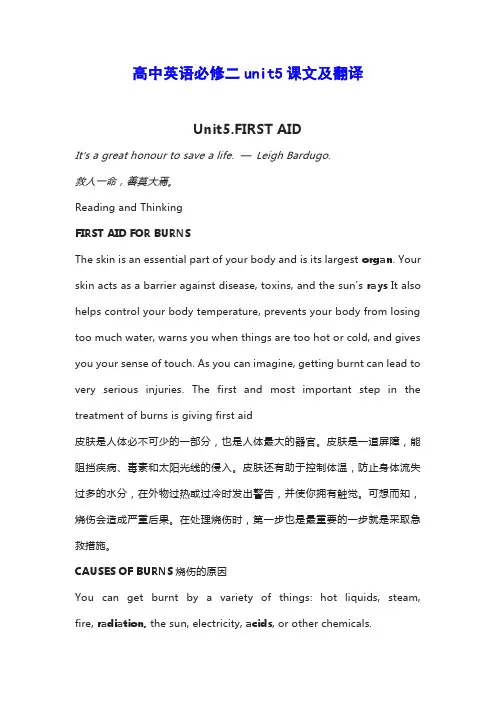
高中英语必修二unit5课文及翻译Unit5.FIRST AIDIt’s a great honour to save a life. —Leigh Bardugo.救人一命,善莫大焉。
Reading and ThinkingFIRST AID FOR BURNSThe skin is an essential part of your body and is its largest organ. Your skin acts as a barrier against disease, toxins, and the sun's rays It also helps control your body temperature, prevents your body from losing too much water, warns you when things are too hot or cold, and gives you your sense of touch. As you can imagine, getting burnt can lead to very serious injuries. The first and most important step in the treatment of burns is giving first aid皮肤是人体必不可少的一部分,也是人体最大的器官。
皮肤是一道屏障,能阻挡疾病、毒素和太阳光线的侵入。
皮肤还有助于控制体温,防止身体流失过多的水分,在外物过热或过冷时发出警告,并使你拥有触觉。
可想而知,烧伤会造成严重后果。
在处理烧伤时,第一步也是最重要的一步就是采取急救措施。
CAUSES OF BURNS烧伤的原因You can get burnt by a variety of things: hot liquids, steam, fire, radiation, the sun, electricity, acids, or other chemicals.很多东西都会造成烧伤:灼热的液体、蒸汽、明火、辐射、太阳光、电流、酸性物质或其他化学品。
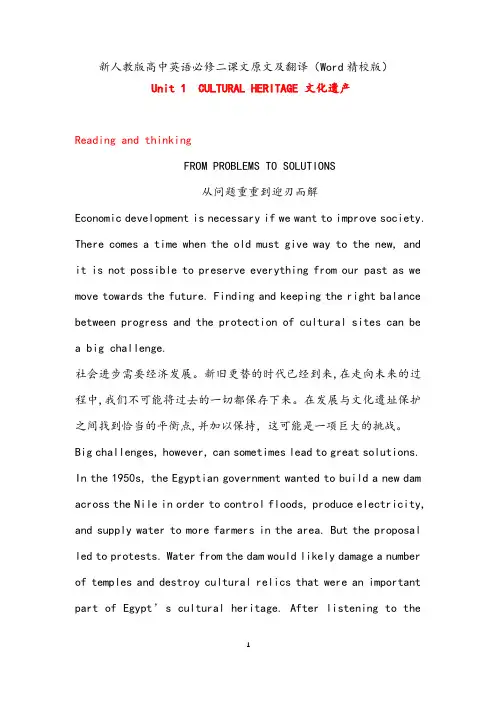
新人教版高中英语必修二课文原文及翻译(Word精校版)Unit 1 CULTURAL HERITAGE 文化遗产Reading and thinkingFROM PROBLEMS TO SOLUTIONS从问题重重到迎刃而解Economic development is necessary if we want to improve society. There comes a time when the old must give way to the new, and it is not possible to preserve everything from our past as we move towards the future. Finding and keeping the right balance between progress and the protection of cultural sites can be a big challenge.社会进步需要经济发展。
新旧更替的时代已经到来,在走向未来的过程中,我们不可能将过去的一切都保存下来。
在发展与文化遗址保护之间找到恰当的平衡点,并加以保持,这可能是一项巨大的挑战。
Big challenges, however, can sometimes lead to great solutions. In the 1950s, the Egyptian government wanted to build a new dam across the Nile in order to control floods, produce electricity, and supply water to more farmers in the area. But the proposal led to protests. Water from the dam would likely damage a number of temples and destroy cultural relics that were an important part of Egypt’s cultural heritage. After listening to thescientists who had studied the problem, and citizens who lived near the dam, the government turned to the United Nations for help in 1959.然而,巨大的挑战有时候会带来伟大的解决方案。
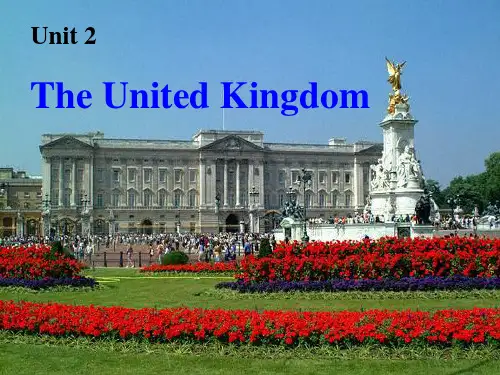
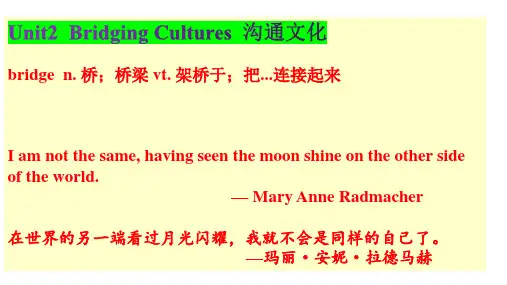
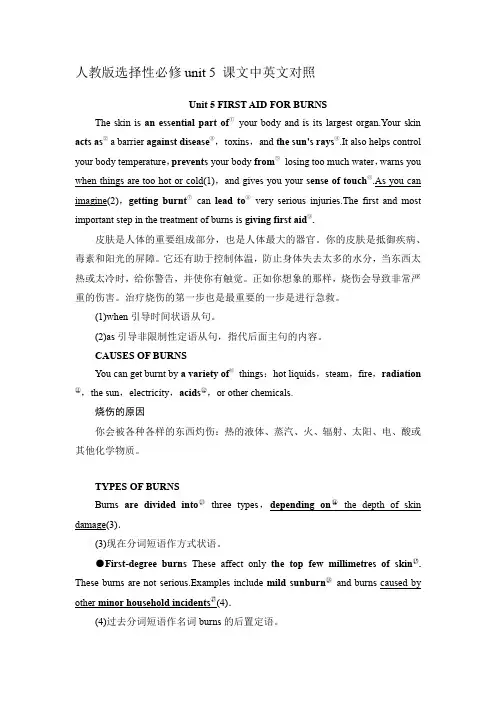
人教版选择性必修unit 5 课文中英文对照Unit 5 FIRST AID FOR BURNSThe skin is an essential part of①your body and is its largest organ.Your skin acts as② a barrier against disease③,toxins,and the sun's rays④.It also helps control your body temperature,prevents your body from⑤losing too much water,warns you when things are too hot or cold(1),and gives you your sense of touch⑥.As you can imagine(2),getting burnt⑦can lead to⑧very serious injuries.The first and most important step in the treatment of burns is giving first aid⑨.皮肤是人体的重要组成部分,也是人体最大的器官。
你的皮肤是抵御疾病、毒素和阳光的屏障。
它还有助于控制体温,防止身体失去太多的水分,当东西太热或太冷时,给你警告,并使你有触觉。
正如你想象的那样,烧伤会导致非常严重的伤害。
治疗烧伤的第一步也是最重要的一步是进行急救。
(1)when引导时间状语从句。
(2)as引导非限制性定语从句,指代后面主句的内容。
CAUSES OF BURNSYou can get burnt by a variety of⑩things:hot liquids,steam,fire,radiation ⑪,the sun,electricity,acids⑫,or other chemicals.烧伤的原因你会被各种各样的东西灼伤:热的液体、蒸汽、火、辐射、太阳、电、酸或其他化学物质。
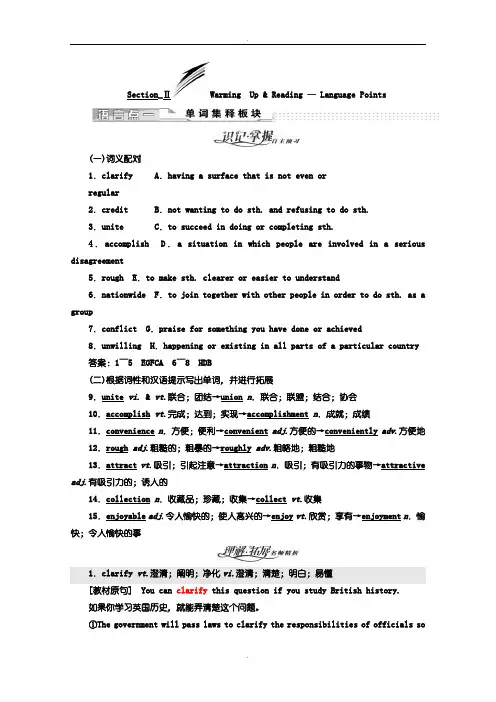
Section_ⅡWarming Up & Reading — Language Points(一)词义配对1.clarify A.having a surface that is not even orregular2.credit B.not wanting to do sth. and refusing to do sth.3.unite C.to succeed in doing or completing sth.4.accomplish D.a situation in which people are involved in a serious disagreement5.rough E.to make sth. clearer or easier to understand6.nationwide F.to join together with other people in order to do sth. as a group7.conflict G.praise for something you have done or achieved8.unwilling H.happening or existing in all parts of a particular country 答案:1~5 EGFCA 6~8 HDB(二)根据词性和汉语提示写出单词,并进行拓展9.unite vi. & vt.联合;团结→union n.联合;联盟;结合;协会10.accomplish vt.完成;达到;实现→accomplishment n.成就;成绩11.convenience n.方便;便利→convenient adj.方便的→conveniently adv.方便地12.rough adj.粗糙的;粗暴的→roughly adv.粗略地;粗糙地13.attract vt.吸引;引起注意→attraction n.吸引;有吸引力的事物→attractive adj.有吸引力的;诱人的14.collection n.收藏品;珍藏;收集→collect vt.收集15.enjoyable adj.令人愉快的;使人高兴的→enjoy vt.欣赏;享有→enjoyment n.愉快;令人愉快的事1.clarify vt.澄清;阐明;净化vi.澄清;清楚;明白;易懂[教材原句] You can clarify this question if you study British history.如果你学习英国历史,就能弄清楚这个问题。

必修5之袁州冬雪创作Unit 1 Great scientistsReadingJOHH SHOW DEFEATS “KING CHOLERA”John Snow was a famous doctor in London - so expert, indeed, that he attended Queen Victoria as her personal physician. But he became inspired when he thought about helping ordinary people exposed to cholera. This was the deadly disease of its day. Neither its cause nor its cure was understood. So many thousands of terrified people died every time there was an outbreak. John Snow wanted to face the challenge and solve this problem. He knew that cholera would never be controlled until its cause was found.He became interested in two theories that possibly explained how cholera killed people. The first suggested that cholera multiplied in the air. A cloud of dangerous gas floated around until it found its victims. The second suggested that people absorbed this disease into their bodies with their meals. From the stomach the diseasequickly attacked the body and soon the affected person died.John Snow suspected that the second theory was correct but he needed evidence. So when another outbreak hit London in 1854, he was ready to begin his enquiry. As the disease spread quickly through poor neighbourhoods, he began to gather information. In two particular streets, the cholera outbreak was so severe that more than 500 people died in ten days. He was determined to find out why.First he marked on a map the exact places where all the dead people had lived. This gave him a valuable clue about the cause of the disease. Many of the deaths were near the water pump in Broad Street (especially numbers 16, 37, 38 and 40). He also noticed that some houses (such as 20 and 21 Broad Street and 8 and 9 Cambridge Street) had had no deaths. He had not foreseen this, so he made further investigations. He discovered that these people worked in the pub at 7 Cambridge Street. They had been given free beer and so had not drunk the water from the pump. It seemed that the water was to blame.Next, John Snow looked into the source of the water for these two streets. He found that it came from the river polluted by the dirty water from London. He immediately told the astonished people in Broad Street to remove the handle from the pump so that it could not be used. Soon afterwards the disease slowed down. He had shown that cholera was spread by germs and not in a cloud of gas.In another part of London, he found supporting evidence from two other deaths that were linked to the Broad Street outbreak. A woman, who had moved away from Broad Street, liked the water from the pump so much that she had it delivered to her house every day. Both she and her daughter died of cholera after drinking the water. With this extra evidence John Snow was able to announce with certainty that polluted water carried the virus.To prevent this from happening again, John Snow suggested that the source of all the water supplies be examined. The water companies were instructed not to expose people to polluted water any more. Finally "King Cholera" was defeated.Using LanguageCOPERNICUS’ REVOLU TIONRRY THEORY Nicolaus Copernicus was frightened and his mind was confused. Although he had tried to ignore them, all his mathematical calculations led to the same conclusion: that the earth was not the centre of the solar system. Only if you put the sun there did the movements of the other planets in the sky make sense. Yet he could not tell anyone about his theory as the powerful Christian Church would have punished him for even suggesting such an idea. They believed God had made the world and for that reason the earth was special and must be the centre of the solar system.The problem arose because astronomers had noticed that some planets in the sky seemed to stop, move backward and then go forward in a loop. Others appeared brighter at times and less bright at others. This was very strange if the earth was the centre of the solar system and all planets went round it.Copernicus had thought long and hard about these problemsand tried to find an answer. He had collected observations of the stars and used all his mathematical knowledge to explain them. But only his new theory could do that. So between 1510 and 1514 he worked on it, gradually improving his theory until he felt it was complete.In 1514 he showed it privately to his friends. The changes he made to the old theory were revolutionary. He placed a fixed sun at the centre of the solar system with the planets going round it and only the moon still going round the earth. He also suggested that the earth was spinning as it went round the sun and this explained changes in the movement of the planets and in the brightness of the stars. His friends were enthusiastic and encouraged him to publish his ideas, but Copernicus was cautious. He did not want to be attacked by the Christian Church, so he only published it as he lay dying in 1543.Certainly he was right to be careful. The Christian Church rejected his theory, saying it was against God's idea and people who supported it would be attacked. Yet Copernicus'theory is now the basis on which all our ideas of the universe are built. His theory WordStrd the Christian idea of gravity, which said things fell to earth because God created the earth as the centre of the universe. Copernicus showed this was obviously wrong. Now people can see that there is a direct link between his theory and the work of Isaac Newton, Albert Einstein and Stephen Hawking.Unit 2 The United KingdomReadingPUZZLES IN GEOGRAPHY People may wonder why different words are used to describe these four countries: England, Wales, Scotland and Northern Ireland. You can clarify this question if you study British history.First there was England. Wales was linked to it in the thirteenth century. Now when people refer to England you find Wales included as well. Next England and Wales were joined to Scotland in the seventeenth century and the name was changed to "Great Britain". Happily this wasaccomplished without conflict when King James of Scotland became King of England and Wales as well. Finally the English government tried in the early twentieth century to form the United Kingdom by getting Ireland connected in the same peaceful way. However, the southern part of Ireland was unwilling and broke away to form its own government. So only Northern Ireland joined with England, Wales and Scotland to become the United Kingdom and this was shown to the world in a new flag called the Union Jack.To their credit the four countries do work together in some areas (eg, the currency and international relations), but they still have very different institutions. For example, Northern Ireland, England and Scotland have different educational and legal systems as well as different football teams for competitions like the World Cup!England is the largest of the four countries, and for convenience it is divided roughly into three zones. The zone nearest France is called the South of England, the middle zone is called the Midlands and the one nearest to Scotlandis known as the North. You find most of the population settled in the south, but most of the industrial cities in the Midlands and the North of England. Although, nationwide, these cities are not as large as those in China, they have world-famous football teams and some of them even have two! It is a pity that the industrial cities built in the nineteenth century do not attract visitors. For historical architecture you have to go to older but smaller towns built by the Romans. There you will find out more about British history and culture.The greatest historical treasure of all is London with its museums, art collections, theatres, parks and buildings. It is the centre of national government and its administration. It has the oldest port built by the Romans in the first century AD, the oldest building begun by the Anglo-Saxons in the 1060s and the oldest castle constructed by later Norman rulers in 1066. There has been four sets of invaders of England. The first invaders, the Romans, left their towns and roads. The second, the Anglo-Saxons, lefttheir language and their government. The third, the Vikings, influenced the vocabulary and place-names of the North of England, and the fourth, the Normans, left castles and introduced new words for food.If you look around the British countryside you will find evidence of all these invaders. You must keep your eyes open if you are going to make your trip to the United Kingdom enjoyable and worthwhile.Using LanguageSIGHTSEEING IN LONDON Worried about the time available, Zhang Pingyu had made a list of the sites she wanted to see in London. Her first delight was going to the Tower. It was built long ago by the Norman invaders of AD 1066. Fancy! This solid stone, square tower had remained standing for one thousand years.Although the buildings had expanded around it, it remained part of a royal palace and prison combined. To her great surprise, Zhang Pingyu found the Queen's jewels guarded by special royal soldiers who, on special occasions, still wore thefour-hundred-year-old uniform of the time of Queen Elizabeth I.There followed St Paul's Cathedral built after the terrible fire of London in 1666. It looked splendid when first built! Westminster Abbey, too, was very interesting. It contained statues in memory of dead poets and writers, such as Shakespeare. Then just as she came out of the abbey, Pingyu heard the famous sound of the clock, Big Ben, ringing out the hour. She finished the day by looking at the outside of Buckingham Palace, the Queen's house in London. Oh, she had so much to tell her friends!The second day the girl visited Greenwich and saw its old ships and famous clock that sets the world time. What interested her most was the longitude line. It is an imaginary line dividing the eastern and western halves of the world and is very useful for navigation. It passes through Greenwich, so Pingyu had a photo taken standing on either side of the line.The last day she visited Karl Marx's statue in HighgateCemetery. It seemed strange that the man who had developed communism should have lived and died in London. Not only that, but he had worked in the famous reading room of the Library of the British Museum. Sadly the library had moved from its original place into another building and the old reading room was gone. But she was thrilled by so many wonderful treasures from different cultures displayed in the museum. When she saw many visitors enjoying looking at the beautiful old Chinese pots and other objects on show, she felt very proud of her country.The next day Pingyu was leaving London for Windsor Castle. "Perhaps I will see the Queen?" she wondered as she fell asleep.Unit 3 Life in the futureReadingFIRST IMPRESSIONSSpacemall: liqiang299A@ 15/11/3008 (Earthtime)Dear Mum and Dad,I still cannot believe that I am taking up this prize that I won last year. I have to remind myself constantly that I am really in AD 3008. Worried about the journey, I was unsettled for the first few days. As a result, I suffered from “Time lag”. This is similar to the “jet lag” you get from flying, but it seems you keep getting flashbacks from your previous time period. So I was very nervous and uncertain at first. However, my friend and guide, Wang Ping, was very understanding and gave me some green tablets which helped a lot. Well-known for their expertise, his parents' company, called "Future Tours", transported me safely into the future in a time capsule.I can still remember the moment when the space stewardess called us all to the capsule and we climbed in through a small opening. The seats were comfortable and after a calming drink, we felt sleepy and closed our eyes. The capsule began swinging gently sideways as we lay relaxed and dreaming. A few minutes later, the journey was completed and we had arrived. I was still on the earth but one thousandyears in the future. What would I find?At first my new surroundings were difficult to tolerate. The air seemed thin, as though its combination of gases had little oxygen left. Hit by a lack of fresh air, my head ached. Just as I tried to make the necessary adjustment to this new situation, Wang Ping appeared. "Put on this mask," he advised. "It'll make you feel much better." He handed it to me and immediately hurried me through to a small room nearby for a rest. I felt better in no time. Soon I was back on my feet again and following him to collect a hovering carriage driven by computer. These carriages float above the ground and by bending or pressing down in your seat, you can move swiftly. Wang Ping fastened my safety belt and showed me how to use it. Soon I could fly as fast as him. However, I lost sight of Wang Ping when we reached what looked like a large market because of too many carriages flying by in all directions. He was swept up into the centre of them. Just at that moment I had a "time lag" flashback and saw the area again as it had been in the year AD 2008. I realized that Ihad been transported into the future of what was still my hometown! Then I caught sight of Wang Ping again and flew after him.Arriving at a strange-looking house, he showed me into a large, bright clean room. It had a green wall, a brown floor and soft lighting. Suddenly the wall moved - it was made of trees! I found later that their leaves provided the room with much-needed oxygen. Then Wang Ping flashed a switch on a computer screen, and a table and some chairs rose from under the floor as if by magic. "Why not sit down and eat a little?" he said. "You may find this difficult as it is your first time travel trip. Just relax, since there is nothing planned on the timetable today. Tomorrow you'll be ready for some visits." Having said this, he spread some food on the table, and produced a bed from the floor. After he left, I had a brief meal and a hot bath. Exhausted, I slid into bed and fell fast asleep.More news later from your loving son,Li QiangUsing LanguageI HAVE SEEN AMAZING THINGSMy first visit was to a space station considered the most modem in space. Described as an enormous round plate, it spins slowly in space to imitate the pull of the earth's gravity. Inside was an exhibition of the most up-to-date inventions of the 31 st century. A guide (G) showed us around along a moveable path.G: Good morning to all our visitors from 2008. First we're going to examine one of the latest forms of communication among our space citizens. No more typists working on a typewriter or computer! No more postage or postcodes! Messages can now be sent using a "thoughtpad". You place the metal band over your head, clear your mind, press the sending button, think your message and the next instant it's sent. It's stored on the "thoughtpad" of the receiver. It's quick, efficient and environmentally friendly. The only limitation is if the user does not think his or her message clearly, anunclear message may be sent. But we cannot blame the tools for the faults of the user, can we?During the explanation I looked at the pair of small objects called "thoughtpads" on a table. They just looked like metal ribbons. So ordinary but so powerful! While I was observing them, the path moved us on.G: And now ladies and gentlemen, we are in the "environment area". People used to collect waste in dustbins. Then the rubbish was sent to be buried or burned, am I fight?(We nodded.) Well, now there's a system where the waste is disposed of using the principles of ecology. A giant machine, always greedy for more, swallows all the waste available. The rubbish is turned into several grades of useful material, such as "fertilizer" for the fields and "soil" for deserts. Nothing is wasted, and everything, even plastic bags, is recycled. A great idea, isn't' it?I stared at the moving model of the waste machine, absorbed by its efficiency. But again we moved on.G: Our third stop shows the changes that have happened to work practices. Manufacturing no longer takes place on the earth but on space stations like this one. A group of engineers programme robots to perform tasks in space.The robots produce goods such as drugs, clothes, furniture, hovering carriages, etc. There is no waste, no pollution and no environmental damage! However, the companies have to train their representatives to live and work in space settlements. They have to monitor the robots and the production. When the goods are ready they're transported by industrial spaceship back to earth.My mind began to wander. What job would I do? My motivation increased as I thought of the wonderful world of the future.Unit 4 Making the newsReadingMY FIRST WORK ASSIGNMENT"Unforgettable", says new journalistNever will Zhou Yang (ZY) forget his first assignment at the office of a popular English newspaper. His discussion with his new boss, Hu Xin (HX), was to strongly influence his life as a journalist.HX: Welcome. We're delighted you're coming to work with us.Your first job here will be an assistant journalist.Do you have any questions?ZY: Can I go out on a story immediately?HX: (laughing) That' s admirable, but I' m afraid it would be unusual ! Wait till you' re more experienced. First we'll put you as an assistant to an experienced journalist. Later you can cover a story and submit the article yourself.ZY: Wonderful. What do I need to take with me? I already have a notebook and camera.HX: No need for a camera. You'll have a professional photographer with you to take photographs. You'll find your colleagues very eager to assist you, so you may be able to concentrate on photography later if you' reinterested.ZY: Thank you. Not only am I interested in photography, but I took an amateur course at university to update my skills.HX: Good.ZY: What do I need to remember when I go out to cover a story?HX: You need to be curious. Only if you ask many different questions will you acquire all the information you need to know. We say a good journalist must have a good "nose" for a story. That means you must be able to assess when people are not telling the whole troth and then try to discover it. They must use research to inform themselves of the missing parts of the story. ZY: What should I keep in mind?HX: Here comes my list of dos and don'ts: don't miss your deadline, don't be rode, don't talk too much, butmake sure you listen to the interviewee carefully. ZY: Why is listening so important?HX: Well, you have to listen for detailed facts. Meanwhile you have to prepare the next question depending onwhat the person says.ZY: But how can I listen carefully while taking notes?HX: This is a trick of the trade, If the interviewee agrees, you can use a recorder to get the facts straight. It'salso useful if a person wants to challenge you. Youhave the evidence to support your story.ZY: I see! Have you ever had a case where someone accused your journalists of getting the wrong end of the stick? HX: Yes, but it was a long time ago. This is how the story goes. A footballer was accused of taking money fordeliberately not scoring goals so as to let the otherteam win. We went to interview him. He denied takingmoney but we were sceptical. So we arranged aninterview between the footballer and the man supposedto bribe him. When we saw them together we guessedfrom the footballer's body language that he was nottelling the truth. So we wrote an article suggestinghe was guilty. It was a dilemma because the footballer could have demanded damages if we were wrong. He tried to stop us publishing it but later we were proved right.ZY: Wow! That was a real "scoop". I'm looking forward to my first assignment now. Perhaps I'll get a scoop too! HX: Perhaps you will. You never know.Using LanguageGETTING THE "SCOOP""Quick," said the editor. "Get that story ready. We need it in this edition to be ahead of the other newspapers. This is a scoop." Zhou Yang had just come back into the office after an interview with a famous film star. "Did he really do that?" asked someone from the International News Department. "Yes, I' m afraid he did," Zhou Yang answered. He set to work.His first task was to write his story, but he had to do it carefully. Although he realized the man had been lying, Zhou Yang knew he must not accuse him directly. He would have tobe accurate. Concise too! He knew how to do that. Months of training had taught him to write with no wasted words or phrases. He sat down at his computer and began to work.The first person who saw his article was a senior editor from his department. He checked the evidence, read the article and passed it on to the copy-editor. She began to edit the piece and design the main headline and smaller heading. “This will look very good on the page,” she said. "Where is a good picture of this man?" Then as the article was going to be written in English Zhou Yang also took a copy to the native speaker employed by the newspaper to polish the style. She was also very happy with Zhou Yang's story. "You are really able to write a good front page article," she said. Zhou Yang smiled with happiness. Last of all, the chief editor read it and approved it. "Well done," he said to Zhou Yang. "But please show me your evidence so we're sure we've got our facts straight.” “I’ll bring it to you immediately," said Zhou Yang excitedly.The news desk editor took the story and began to work onall the stories and photos until all the pages were set. All the information was then ready to be processed into film negatives. This was the first stage of the printing process. They needed four negatives, as several colours were going to be used on the story. Each of the main colours had one negative sheet and when they were combined they made a coloured page for the newspaper. After one last check the page was ready to be printed. Zhou Yang waited excitedly for the first copies to be ready. "Wait 611 tonight," his friend whispered. "I expect there will be something about this on the television news. A real scoop!"Unit 5 First aidReadingFIRST AID FOR BURNSThe skin is an essential part of your body and its largest organ. You have three layers of skin which act as a barrier against disease, poisons and the sun's harmful rays. The functions of your skin are also very complex: it keeps you warm or cool; it prevents your body from losing too muchwater; it is where you feel cold, heat or pain and it gives you your sense of touch. So as you can imagine, if your skin gets burned it can be very serious. First aid is a very important first step in the treatment of bums.Causes of burnsYou can get burned by a variety of things: hot liquids, steam, fire, radiation (by being close to high heat or fire, etc), the sun, electricity or chemicals.Types of burnsThere are three types of burns. Burns are called first, second or third degree burns, depending onwhich layers of the skin are burned.◎ First degree burns These affect only the top layer of the skin. These burns are not serious and should feel better within a day or two. Examples include mild sunburn and burns caused by touching a hot pan, stove or iron for a mordent.◎ Second degree burns These affect both the top and the second layer of the skin. These bums are serious andtake a few weeks to heal. Examples include severe sunburn and bums caused by hot liquids.◎Third degree burns These affect all three layers of the skin and any tissue and organs under the skin.Examples include burns caused by electric shocks, burning clothes, or severe petrol fires. These burns cause very severe injuries and the victim must go to hospital at once.Characteristics of burnsFirst degree burns◎ dry, red and mildly swollen◎ mildly painful◎ turn white when pressedSecond degree burns◎ rough, red and swollen◎ blisters◎ watery surface◎ extremely painfulThird degree burns◎ black and white and charred◎ swollen; often tissue under them can be seen◎little or no pain if nerves are damaged; may be painaround edge of injured area. First aid treatment1 Remove clothing using scissors if necessary unless it is stuck to the burn. Take off other clothing and jewellery near the burn.2 Cool burns immediately with cool but not icy water. It is best to place burns under gently running water for about 10 minutes. (The cool water stops the burning process, prevents the pain becoming unbearable and reduces swelling.) Do not put cold water on third degree burns.3 For first degree burns, place cool, clean, wet cloths on them until the pain is not so bad. For second degree burns, keep cloths cool by putting them back in a basin of cold water, squeezing them out and placing them on the burned area over and over again for about an hour until the pain is not so bad.4 Dry the burned area gently. Do not rob, as this may break any blisters and the wound may get infected.5 Cover the burned area with a dry, clean bandage that will not stick to the skin. Hold the bandage in place with tape. Never put butter, oil or ointment on bums as they keep the heat in the wounds and may cause infection.6 If bums are on arms or legs, keep them higher than the heart, if possible. If bums are on the face, the victim should sit up.7 If the injuries are second or third degree bums, it is vital to get the victim to the doctor or hospital at once.Using LanguageHEROIC TEENAGER RECEIVES AWARD Seventeen-year-old teenager, John Janson, was honoured at the Lifesaver Awards last night in Rivertown for giving lifesaving first aid on his neighbour after a shocking knife attack.John was presented with his award at a ceremony which recognized the bravery of ten people who had saved the lifeof another.John was studying in his room when he heard screaming. When he and his father rushed outside, a man ran from the scene. They discovered that Anne Slade, mother of three, had been stabbed repeatedly with a knife. She was lying in her front garden bleeding very heavily. Her hands had almost been cut off.It was John's quick action and knowledge of first aid that saved Ms Slade's life. He immediately asked a number of nearby people for bandages, but when nobody could put their hands on any, his father got some tea towels and tape from their house. John used these to treat the most severe injuries to Ms Slade's hands. He slowed the bleeding by applying pressure to the wounds until the police and ambulance arrived."I'm proud of what I did but I was just doing what I'd been taught," John said.John had taken part in the Young Lifesaver Scheme at his high school. When congratulating John, Mr Alan Southerton,Director of the Young Lifesaver Scheme said, "There is no doubt that John's quick thinking and the first aid skills he learned at school saved Ms Slade's life. It shows that a knowledge of first aid can make a real difference."Before receiving their awards last night, John and the nine other Life Savers attended a special reception yesterday hosted by the Prime Minister.。
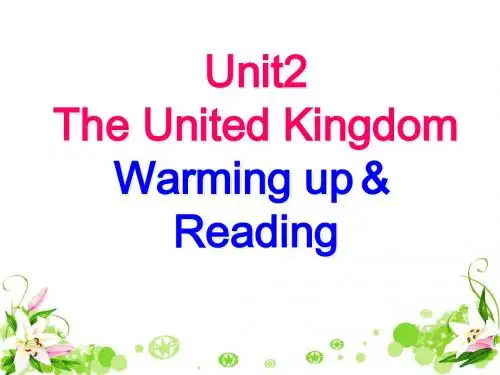
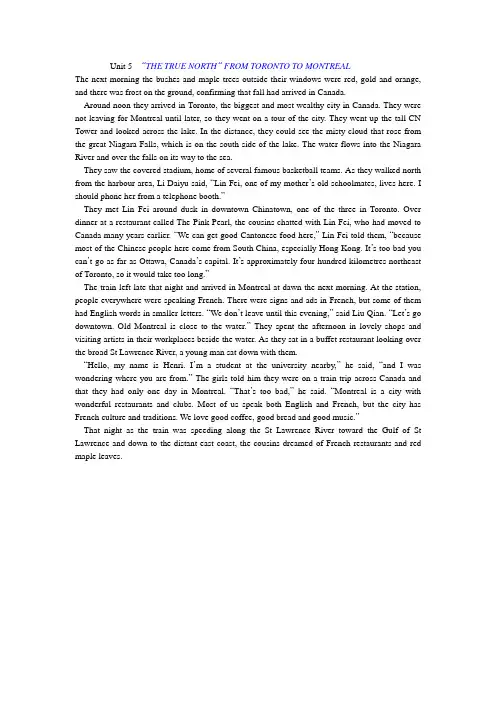
Unit 5 “THE TRUE NORTH” FROM TORONTO TO MONTREALThe next morning the bushes and maple trees outside their windows were red, gold and orange, and there was frost on the ground, confirming that fall had arrived in Canada.Around noon they arrived in Toronto, the biggest and most wealthy city in Canada. They were not leaving for Montreal until later, so they went on a tour of the city. They went up the tall CN Tower and looked across the lake. In the distance, they could see the misty cloud that rose from the great Niagara Falls, which is on the south side of the lake. The water flows into the Niagara River and over the falls on its way to the sea.They saw the covered stadium, home of several famous basketball teams. As they walked north from the harbour area, Li Daiyu said, “Lin Fei, one of my mother’s old schoolmates, lives here. I should phone her from a telephone booth.”They met Lin Fei around dusk in downtown Chinatown, one of the three in Toronto. Over dinner at a restaurant called The Pink Pearl, the cousins chatted with Lin Fei, who had moved to Canada many years earlier. “We can get good Cantonese food here,” Lin Fei told them, “because most of the Chinese people here come from South China, especially Hong Kong. It’s too bad you can’t go as far as Ottawa, Canada’s capital. It’s approximately four hundred kilometres northeast of Toronto, so it would take too long.”The train left late that night and arrived in Montreal at dawn the next morning. At the station, people everywhere were speaking French. There were signs and ads in French, but some of them had English words in smaller letters. “We don’t leave until this evening,” said Liu Qian. “Let’s go downtown. Old Montreal is close to the water.”They spent the afternoon in lovely shops and visiting artists in their workplaces beside the water. As they sat in a buffet restaurant looking over the broad St Lawrence River, a young man sat down with them.“Hello, my name is Henri. I’m a student at the university nearby,”he said, “and I was wondering where you are from.” The girls told him they were on a train trip across Canada and that they had only one day in Montreal. “That’s too bad,”he said. “Montreal is a city with wonderful restaurants and clubs. Most of us speak both English and French, but the city has French culture and traditions. We love good coffee, good bread and good music.”That night as the train was speeding along the St Lawrence River toward the Gulf of St Lawrence and down to the distant east coast, the cousins dreamed of French restaurants and red maple leaves.。
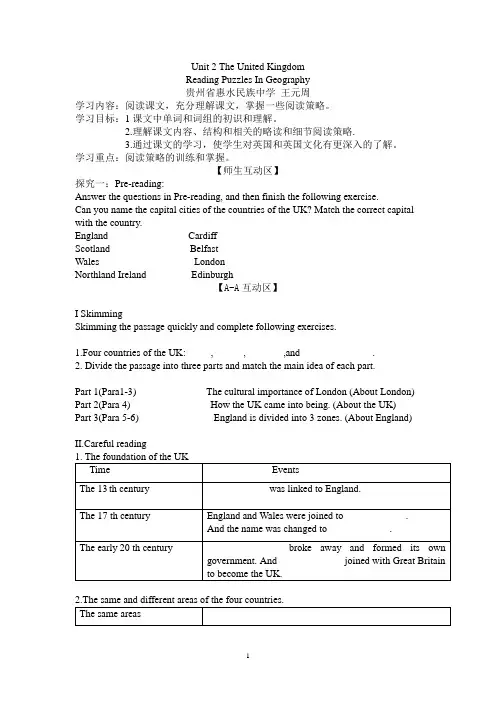
Unit 2 The United KingdomReading Puzzles In Geography贵州省惠水民族中学王元周学习内容:阅读课文,充分理解课文,掌握一些阅读策略。
学习目标:1课文中单词和词组的初识和理解。
2.理解课文内容、结构和相关的略读和细节阅读策略.3.通过课文的学习,使学生对英国和英国文化有更深入的了解。
学习重点:阅读策略的训练和掌握。
【师生互动区】探究一:Pre-reading:Answer the questions in Pre-reading, and then finish the following exercise.Can you name the capital cities of the countries of the UK? Match the correct capitalwith the country.England CardiffScotland BelfastWales LondonNorthland Ireland Edinburgh【A-A互动区】I SkimmingSkimming the passage quickly and complete following exercises.1.Four countries of the UK:_____,______, _______,and ______________.2. Divide the passage into three parts and match the main idea of each part.Part 1(Para1-3) The cultural importance of London (About London)Part 2(Para 4)How the UK came into being. (About the UK)Part 3(Para 5-6)England is divided into 3 zones. (About England)II.Careful reading1. The foundation of the UKTime EventsThe 13th century ____________ was linked to England.The 17 th century England and Wales were joined to ____________.And the name was changed to ____________.The early 20 th century ______ _______ broke away and formed its owngovernment. And ______ ______ joined with Great Britainto become the UK.2.The same and different areas of the four countries.The same areasDifferent institutions3. Something about England.Divided zones characteristic pride The pitymost of the _______ settled ________ footballteamsThe ______citiesdo not attractvisitors.most of the _____cities4.London: the greatest ________ treasure, the centre of national _______ and its _________. Four sets of invaders and their influence:Time Invaders InfluenceTowns and roadsIn the 1060sThe VikingsIn 1066III. A-A同学互相核对答案,标注解答对方答不出的内容,并大声朗读该部分内容,相互纠正语音。
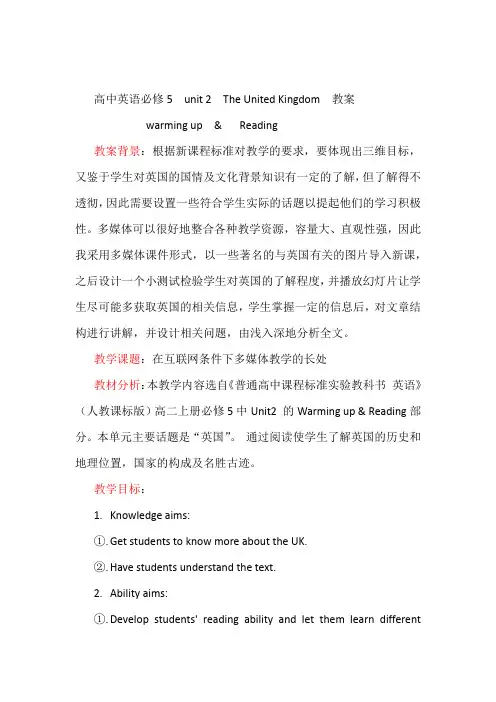
高中英语必修5 unit 2 The United Kingdom教案warming up&Reading教案背景:根据新课程标准对教学的要求,要体现出三维目标,又鉴于学生对英国的国情及文化背景知识有一定的了解,但了解得不透彻,因此需要设置一些符合学生实际的话题以提起他们的学习积极性。
多媒体可以很好地整合各种教学资源,容量大、直观性强,因此我采用多媒体课件形式,以一些著名的与英国有关的图片导入新课,之后设计一个小测试检验学生对英国的了解程度,并播放幻灯片让学生尽可能多获取英国的相关信息,学生掌握一定的信息后,对文章结构进行讲解,并设计相关问题,由浅入深地分析全文。
教学课题:在互联网条件下多媒体教学的长处教材分析:本教学内容选自《普通高中课程标准实验教科书英语》(人教课标版)高二上册必修5中Unit2 的Warming up & Reading部分。
本单元主要话题是“英国”。
通过阅读使学生了解英国的历史和地理位置,国家的构成及名胜古迹。
教学目标:1. Knowledge aims:①. Get students to know more about the UK.②. Have students understand the text.2. Ability aims:①. Develop students' reading ability and let them learn differentreading skills.②. Enable students to learn more about the UK.3. Emotional aims:①. Stimulate students' great interest in information about the UK.②. Inspire students' sense of cooperative learning.教学重点:1. Let students read the passage Puzzles in Geography and learn something about the UK.2. Develop students' reading ability.教学难点:1. Enable students to use different reading skills.2. Develop students' reading ability.教学方法:1. Task-based Language Teaching2. Cooperative learning教学工具:Multimedia、blackboard and chalk教学过程:Step 1 Lead inShow some pictures of the UK. (pitures)Step 2 Learning Aims:1.Know more about the UK( the four parts,t he three zones,thefour invaders)2. Try to understand the text.3. Develop reading ability and learn different reading skills.Step3Warming upDo this quiz and find out how much you know about the UK.1. How many countries does the UK consist of ?A.twoB. threeC. four2. How long does it take to fly from Beijing to London Heathrow Airport?A. about six hoursB. about ten hoursC. about sixteen hours3. Who rules the country: the Prime Minister or the queen?A. The QueenB. The Prime MinisterC. both4. What are the provinces called in England?A. countiesB. departmentsC. states5. Which is the longest river in England?A. The River AvonB. The River ThamesC. The River SevernAt the same time, give some explanations and show some related pictures(pitures)Step 3Reading (I):Read the passage for the first time and answer the following questions.1.What are the four countries of UK?2.When was Wales linked to England ?3.When did the name “Great Britain” appear?4.What are the differences among the flags of the UK?5.What area do the four countries work together?6.What are the four countries’ differences?7.What are the features of the South , the Midlands and North ofEngland?8.How many invaders invaded England?9.How did the four invaders influence England?Step 4Reading (II):Match the main idea of each paragraphPara 1Explains what the ter m “Great Britain” means and how it came aboutPara 2 Explains how England is divided into three zonesPara 3 Explains differences in the four countriesPara 4 States the topic to be examined in the readingPara 5 Explains the importance of London as a cultural and political center in the UKPara 6 Explains the joining of England and WalesStep 5Reading (III)Divide the passage into three parts and write down the main ideaof each part.Part 1(Para.1): Statesthe topic to be examined in the readingPart 2(Para.2—5): Explains how the UK came about, the differencesbetweenthefour countries and betweenthree zones of England.Part 3(Para.6): Explains the important role London plays as a cultural and political center of the UK.Step 6 ExerciseFill in the blanks according to the passage.1) The UK __________four countries: England, Wales, Scotland andNorthern Ireland. England is the largest of the fourcountries, and it is __________ three zones: the Southof England, the Midlands and the North. NorthernIreland _______________ Britain mainland by thesea.2) First there was England. Wales ___________ it in the thirteenthcentury.Next England and Wales_____________Scotland in the seventeenthcentury.Finally Northern Ireland___________England, Wales and Scotland to becomethe United Kingdom.Step 7 SummaryThis class we have briefly learned the history of the UK, including its four parts ,three zones, and the four invaders in itshistory and how they influenced England.Step 8 Homework1. Read the whole passage and write a short summary of it .2.Find the useful words and phrases and remember the keysentences3. Go to the net to get more information about UK.教学反思本节课以新课改的理念及我校——《秦岭中学课改指导意见》为基本指导整堂课的教学,通过展示图片、播放幻灯片等各种方式,设计各种活动引发学生思考,充分调动学生的主动性,很好地体现了新课改的要求――学生主体、教师指导。
-必修 5Unit 2 The United KingdomReadingPUZZLES IN GEOGRAPHYPeople may wonder why different words are used to describe these four countries: England, Wales, Scotland and Northern Ireland. You can clarify this question if you study British history.First there was England. Wales was linked to it in the thirteenth century. Now when people refer to England you find Wales included as well. Next England and Wales were joined to Scotland in the seventeenth century and the name was changed to "Great Britain". Happily this was accomplished without conflict when King James of Scotland became King of England and Wales as well. Finally the English government tried in the early twentieth century to form the United Kingdom by getting Ireland connected in the same peaceful way. However, the southern part of Ireland was unwilling and broke away to form its own government. So only Northern Ireland joined with England, Wales and Scotland to become the United Kingdom and this was shown to the world in a new flag called the Union Jack.To their credit the four countries do work together in some areas (eg, the currency and international relations), but they still have very different institutions. For example, Northern Ireland, England and Scotland have different educational and legal systems as well as different football teams for competitions like the World Cup! England is the largest of the four countries, and for convenience it is divided roughly into three zones. The zone nearest France is called the South of England, the middle zone is called the Midlands and the one nearestto Scotland is known as the North. You find most of the population settled in the south, but most of the industrial cities in the Midlands and the North of England. Although, nationwide, these cities are not as large as those in China, they have world-famous football teams and some of them even have two! It is a pity that the industrial cities built in the nineteenth century do not attract visitors. For historical architecture you have to goto older but smaller towns built by the Romans. There you will find out more about British history and culture.The greatest historical treasure of all is London with its museums, art collections, theatres, parks and buildings. It is the centre of national government and its administration. It has the oldest port built by the Romans in the first century AD, the oldest building begun by the Anglo-Saxons in the 1060s and the oldest castle constructed by later Norman rulers in 1066. There has been four sets of invaders of England. The first invaders, the Romans, left their towns and roads. The second, the Anglo-Saxons, left their language and their government. The third, the Vikings, influenced the vocabulary and place-names of the North of England, and the fourth, the Normans, left castles and introduced new words for food.If you look around the British countryside you will find evidence of all these invaders. You must keep your eyes open if you are going to make your trip to the United Kingdom enjoyable and worthwhile.人们可能会奇怪为什么用不同的词语来描述英格兰、威尔士、苏格兰和北爱尔兰这四个国家。
Unit 2 English around the worldWords and expressions:1 .voyage n. [C] 航行;航海He was a young sailor on his first sea voyage.travel, journey, trip,voyage& tour的区别travel 用作不可数名词, 只用于泛指从某地去另一地, 如果某人在某段时间里到处走, 可用travels;journey 用作可数名词, 表示去某地所花的时间和旅行的距离, 尤指较长距离的或定期的旅行;trip 用作可数名词, 表示非定期的, 也许较短的往返旅行;voyage 则常指海上旅行或太空旅行。
tour指以游览、观光、购物等目的的旅行。
也指巡视。
巡回比赛或演出It’s a long ____________ from here to Hong Kong.It’s only three hours’ ________________ from hereHe wrote a book about his __________ in South Africa.When i give up work, I shall make a long __________ at sea.The band is on ___________ in France2 because of: as a result of 因为; 由于Many beautiful fish are fast disappearing ________________ the severe pollution.因为污染严重,许多美丽的鱼类正在面临绝种。
The police are advising motorists to reduce speed ______________ the fog.由于有雾,警察告诫驾车者减慢速度。